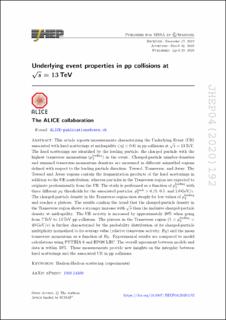Underlying event properties in pp collisions at √s = 13 TeV
Acharya, Shreyasi; Adamová, Dagmar; Adler, Alexander; Adolfsson, Jonatan; Aggarwal, Madan M.; Aglieri Rinella, Gianluca; Agnello, Michelangelo; Agrawal, Nikita; Ahammed, Zubayer; Ahmad, Shafiq F.; Alme, Johan; Altenkaemper, Lucas; Djuvsland, Øystein; Eikeland, Viljar Nilsen; Ersdal, Magnus Rentsch; Fionda, Fiorella Maria Celeste; Grøttvik, Ola Slettevoll; Lofnes, Ingrid Mckibben; Nystrand, Joakim; Rehman, Attiq Ur; Røhrich, Dieter; Tambave, Ganesh Jagannath; Ullaland, Kjetil; Wagner, Boris; Yang, Shiming; Yuan, Shiming; Zhou, Zhuo; Arsene, Ionut Cristian; Dordic, Olja; Lardeux, Antoine Xavier; Mahmood, Sohail Musa; Malik, Qasim Waheed; Neagu, Alexandra; Richter, Matthias; Røed, Ketil; Skaali, Toralf Bernhard; Tveter, Trine Spedstad; Wikne, Jon Christopher; Helstrup, Håvard; Hetland, Kristin Fanebust; Kileng, Bjarte; Nesbø, Simon Voigt; Storetvedt, Maksim Melnik; Langøy, Rune; Lien, Jørgen André; Ahn, Sang Un; Akindinov, Alexander; Al-Turany, Mohammed; Alam, Sk Noor; De Albuquerque, Danilo Silva; ALICE, Collaboration
Journal article, Peer reviewed
Published version

Åpne
Permanent lenke
https://hdl.handle.net/11250/2735692Utgivelsesdato
2020Metadata
Vis full innførselSamlinger
Sammendrag
This article reports measurements characterizing the Underlying Event (UE) associated with hard scatterings at midrapidity (|η| < 0.8) in pp collisions at √s = 13 TeV. The hard scatterings are identified by the leading particle, the charged particle with the highest transverse momentum (p_T^leading) in the event. Charged-particle number-densities and summed transverse-momentum densities are measured in different azimuthal regions defined with respect to the leading particle direction: Toward, Transverse, and Away. The Toward and Away regions contain the fragmentation products of the hard scatterings in addition to the UE contribution, whereas particles in the Transverse region are expected to originate predominantly from the UE. The study is performed as a function of p_T^leading with three different pT thresholds for the associated particles, p_T^track > 0.15, 0.5, and 1.0 GeV/c. The charged-particle density in the Transverse region rises steeply for low values of p_T^leading and reaches a plateau. The results confirm the trend that the charged-particle density in the Transverse region shows a stronger increase with √s than the inclusive charged-particle density at midrapidity. The UE activity is increased by approximately 20% when going from 7 TeV to 13 TeV pp collisions. The plateau in the Transverse region (5 <p_T^leading< 40 GeV/c) is further characterized by the probability distribution of its charged-particle multiplicity normalized to its average value (relative transverse activity, RT) and the mean transverse momentum as a function of RT. Experimental results are compared to model calculations using PYTHIA 8 and EPOS LHC. The overall agreement between models and data is within 30%. These measurements provide new insights on the interplay between hard scatterings and the associated UE in pp collisions.
